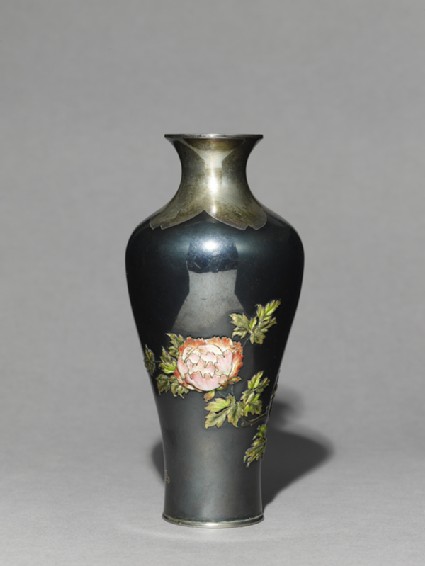Browse: 1 object
- Reference URL
Actions
Baluster vase with poppies and tree peonies
-
Details
- Associated place
- Date
- 1890s
- Artist/maker
-
Takasaki Kōichi (active c. 1900)
- Material and technique
- bronze, overlaid with shibuichi, and with cloisonné enamel; neck overlaid with silver
- Dimensions
-
17.8 cm (height)
8.2 cm (diameter)
at base 4.7 cm (diameter)
- Material index
-
processed material › metal › alloy › copper alloy › bronze,processed material › metal › alloy › silver alloy › shibuichi,processed material › metal › alloy › copper alloy › shibuichi,
- Technique index
- Object type index
-
container › vessel › vase › baluster vase
- No. of items
- 1
- Credit line
- Purchased with the assistance of the Story Fund, 1994.
- Accession no.
- EA1994.109
-
Further reading
Impey, Oliver, and Joyce Seaman, Japanese Decorative Arts of the Meiji Period 1868-1912, Ashmolean Handbooks (Oxford: Ashmolean Museum, 2005), no. 26 on p. 56, illus. pp. 56-57
Glossary (2)
cloisonné, shibuichi
-
cloisonné
Decorative technique in which wires are attached to a metal body and coloured enamels are applied between the wires.
-
shibuichi
alloy of copper and silver, patinated to a dull grey-green colour
Location
Objects are sometimes moved to a different location. Our object location data is usually updated on a monthly basis. Contact the Jameel Study Centre if you are planning to visit the museum to see a particular object on display, or would like to arrange an appointment to see an object in our reserve collections.
Galleries
Publications online
-

Japanese Decorative Arts of the Meiji Period
Baluster vase in silver, shibuichi, and cloisonné enamel. The neck in silver with petal-shapes on the shoulder, the body decorated with tree peonies in relief in cloisonné enamel. Engraved signature on exterior: Hōryūsai Kōichi with gold inlaid kakihan and on the base: Takasaki Seizō.
Details of the life of Takasaki Kōichi, appear to be unknown; however there exists a groups of vases, usually of bronze and silver, and encrusted with shippō (cloisonné) inlays in which there is a silver neck that either simulates dripping of a liquid over the bronze or fuses into the bronze in a careful pattern, some of which are signed Takasaki Kōichi or Hōryūsai Kōichi (as here), which can all be attributed to Kōichi. In the Paris Exposition of 1900, Takasaki Kōichi exhibited a pair of silver vases decorated with peonies and poppies in cloisonné enamel.
© 2013 University of Oxford - Ashmolean Museum











